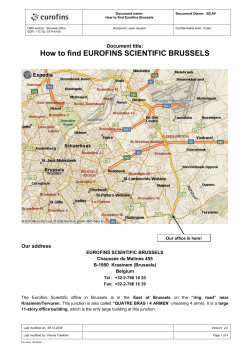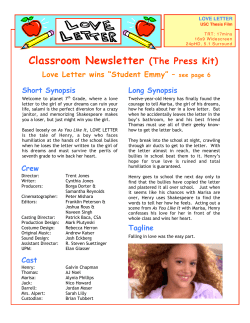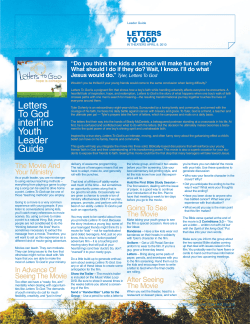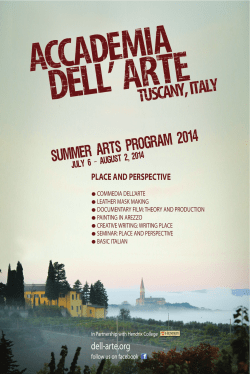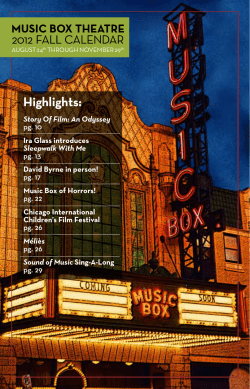
Document 27905
2 “The city is like life, you build and you break down and then you build again.” (Bilal) synopsis 4 ‘Welcome Home’ shows three intense moments in the life of Lila. She is the common thread between three men she meets during significant instants of her existence. The film is a sharp love letter to Brussels, a city in a constant state of flux, a Babylon with coming-and-going inhabitants, affected by the constant transformation of its urbanism and buildings. Director Tom Heene Cast Manah Depauw, Kurt Vandendriessche, Nader Farman, Felipe Mafasoli Cinematography Fred Noirhomme Editing David Verdurme Music Peter Lenaerts Production Minds Meet & La Parti In association with Alea Jacta & Stempel With the support of Flanders Audiovisual Fund, Flanders Image, Centre du Cinéma et de l’Audiovisuel de la Communauté Française de Belgique & de VOO Belgium - 73’ - 2012 - colour - DCP - Dolby SRD Facebook: http://www.facebook.com/pages/ Welcome-Home/306032279468557 Trailer: http://vimeo.com/46932097 info@mindsmeet.be | +32 476 46 01 54 5 6 7 conversation with the director 8 Welcome Home, Tom Heene’s debut feature, began as three interlinked short films, 3 X Lila. The project is set in Brussels, the city where the director is based. At night, a car carrying some spoiled young ‘eurocrats’ to a party, crashes into a bicyclist. She is badly hurt. This is Lila, a young woman recently returned to Belgium from travels abroad. Fiercely independent, she is in the process of splitting up with her boyfriend Benjamin, even if she is still as physically attracted to him as ever. We see her arriving at the airport in Brussels and accompanying an Iranian man in the bus to the city centre. He hasn’t been in the city for years and is bewildered by how it has changed, with its new array of skyscrapers and glass-fronted office blocks. From: Flanders i magazine 21, Autumn 2011 Text: Geoffrey Macnab The basis was seeing Brussels as a map of trajectories that cross each other, Heene says of the Short Cuts-style structure of Welcome Home. ‘I’ve lived 20 years in Brussels. People leave and people come back… the film is close to how I feel about this town.’ If Welcome Home is a love letter to Brussels, it is a very barbed one. The city is in a constant state of flux. This is underlined by the different languages used by the people in the film (English, Dutch, French) by the coming and going of the characters and by the transformations in the buildings. The Iranian man, revisiting Brussels after so long away, tells Lila that the architect who has built all these impersonal, modernist structures should be ‘whipped’. Does the director feel the Iranian’s anger about the ways in which the city has changed? ‘You know, I was born in Ghent which they say in the “Lonely Planet” is one of Belgium’s best-kept secrets,’ Heene reflects on his upbringing ‘I adore going back. My family is still there but… I am unable to go and live there!’ Brussels, Heene elaborates, is a much darker metropolis than Ghent. It is a place ‘where all nationalities cross.’ He talks of his love/hate relationship with the city. ‘It’s the arena for a lot of confrontations and tensions.’ Whatever else, Brussels is potentially a rich and fascinating place in which to make movies – and Heene believes that Belgian filmmakers haven’t always taken advantage of the stories in their backyards. 9 10 11 Today’s sexuality The settings of Welcome Home range from Brussels by night to the small apartment where Lila (Manah Depauw) and her boyfriend (Kurt Vandendriessche) have their ferociously intense reunion. This segment of the story features anguished and aggressive sex between the lovers who have such different expectations about one another. The final part of the story is set in a Brussels hospital. Heene describes Lila as a modern woman, one of ‘the daughters of the feminists.’ On the one hand, she is liberated, individualistic and determined not to be dependent on a man. On the other, she craves security and intimacy. This part of the film ‘is all about today’s sexuality – how a woman lives her sexuality and how a man lives his sexuality. Maybe I wanted to show an image of a couple which was not this classical “man wants to fuck and woman wants a man for a baby”.’ For a young western woman in her mid-20s, Heene suggests, ‘the situation is very complex.’ Should she want to be in a relationship for the rest of her life or to enjoy the freedom that being on her own brings? The scene in the apartment, which was shot over four nights, is raw and unsettling. Heene captures the contradictory feelings of the lovers: their desire for one another but also their animosity and suspicion. After an early screening, Heene was told by an acquaintance that the scene between Lila and her boyfriend was ‘very respectful’ because it turned gender stereotypes on their head. For once, the woman was not simply the object of desire. She was the one pursuing and roughly seducing the man. ‘We are not there to show the ass or the breasts of the woman. No, it’s like they are two bodies together… We must not be afraid of showing how things go. Let’s find a way of showing how strong a woman can be at that moment also.’ Jan Fabre Kurt Vandendriessche has worked extensively with artist and choreographer Jan Fabre – one reason that he was comfortable with a role as fraught and physically demanding as that of the boyfriend. Depauw, an artist and a director as well as an actress, likewise confronted the challenge head on. ‘For them, it was an intriguing moment naturally. They really wanted to succeed in this,’ Heene says of his two leads. ‘I had a lot of trust… more than my crew in fact! I wanted the actors to go for it and try stuff out. As they are very good actors but also physical, it worked. It was very emotional for both of them. They dug very deep.’ Welcome Home may be Heene’s first feature as a director but he has been active in Belgian film culture for many years. He was production manager on the Brussels part of The Five Obstructions, the project hatched by Jorgen Leth and Lars Von Trier. He has also worked as assistant director and production assistant on many other films. Among his recent credits are Alex Stockman’s Pulsar and Olivier Smolders’ Nuit noire. Meanwhile, he has created several media installations, among them the ongoing project DarkMatr, which investigates the way ‘data from the web and our physical world can be merged and presented in a total user experience.’ He has juggled his own intensely personal projects with his work for other directors. Heene remembers that when he was working on The Five Obstructions, he was already thinking about making films in Brussels. ‘It took a long time before I did my own projects. One way or another, I fell into production management and assistant directing. I suppose I have a talent for organizing and for keeping budgets.’ When he finally got round to shooting his own films, he couldn’t help but ask himself: ‘jeez, why didn’t I start before!’ He adds that his own experiences gave him an added respect for the work of the crew. ‘Filmmaking is really collaboration. You do not do it alone. I am not the only artist.’ 12 Now in his early 40s, Heene went to film school at Sint-Lukas when he was very young in the late 1980s. Once there, he switched from film directing to experimental video. ‘Immediately, when you are at film school, they push you toward a kind of classical filmmaking where I didn’t feel very at home,’ he recalls. ‘I always had an affinity with video. I am in love with narrative film but also with the more experimental side of image and sound.’ With his background in video, Heene has been well placed to investigate the way that storytelling has been changing in the digital age. ‘Cinema, in a way, is dying,’ the director says. ‘Arthouse cinema is searching for a way for surviving at the moment… maybe at a certain moment, it will be online. Maybe that will be the only way: have your movie on iTunes and let people pay €5 for it – but I think we still are social animals.’ His own passion for cinema began when he was a kid in Ghent, watching - movies at Studio Skoop or watching films – ‘the forbidden thing’ - on a colour TV in the attic. In his teenage years, he was a big admirer of films like Alan Parker’s Birdy, Leos Carax’s Mauvais sang and Wim Wenders’ Wings Of Desire and Paris, Texas. Welcome Home is being made with the support, over time, of several production outfits: Tomas Leyers’ Minds Meet, Corridor (where the film was championed by Kaat Camerlynck) and La Parti Production. Now, Heene is determined to make up for lost time. ‘I was 18 when I went to film school,’ he says. ‘I am not so prodigious because I only did my first film now – and I am 41.’ Once his feature debut is fully completed, the director will be looking to make more films – and, yes, they will almost certainly be set in Brussels. 13 director’s note 14 Brussels calls itself the capital of Europe. It is also a schizophrenic character with a complex richness. When a foreigner, who has already lived here for several years, gives his opinion about the city you systematically hear contrasting answers. Brussels is both regional and international, village and urban, ugly and beautiful, bright and gray, open and closed, boring and exciting. Many of these foreigners are “stuck” and have a love-hate relationship forged with the city. Some are downright negative but those who stay longer finally surrender themselves to the hidden charms. My own first encounter with Brussels was the complex area around the North Station, where I rented a room whilst in film school. Glass office boxes and bureaucrats next to prostitutes and sex shops, Turkish and Moroccan shops, litter, food and exotic music and sometimes palpable violence. Coming from the Flemish and “white” Gent, the confrontation was radical and intense. After a first year within the safe walls of the school the discovery began. Slowly, the city started to expose itself and my circle of friends grew. It eventually became a constant encounter with new worlds. 15 16 With Welcome Home, I wanted to make a portrait of people who spend their lives in Brussels. It’s about the difficulties they encounter entering into relationships with each other, let alone themselves, and the way they cope with it. Their story is anchored in a city that indirectly affects their actions. Welcome Home is therefore as much about the identity of a metropolis where life seems as universal as in other cities but still a strange personality that you find nowhere else. Brussels is the capital of a divided country that, politically and culturally, is constantly looking for identity. In addition, it claims to be the capital of the European Union, which means that it is the city where the various European communities are in constant confrontation with each other. Actually, Brussels is much more than a European capital, figures show that by 2013 the population will consist of immigrants of European and non-European origin. Brussels and its inhabitants are an inexhaustible source of inspiration, positive and negative. The city has a lot of sore spots and sometimes the confrontation is violent. The hesitant way in which matters such as urbanisation, architecture, traffic, public transport, services, social and environmental policies, unemployment and poverty are addressed has an impact on the lifestyle of its inhabitants. The city is a small Babel where people are constantly searching for the right language, literally and figuratively, to understand each other. In Welcome Home the city is a character on its own. Besides the restless handheld images that show the actors in their natural surroundings, Brussels is filmed in static night sequences that dictate the rhythm of the film but also provide a breathing space for the tensions between the characters themselves. The film does not shy away from confrontation and builds a tension that involves the spectator. What happens in the film is close to personally experienced situations. The Eurocrats portrayed are people you can easily meet in the city. The clash in the film accelerates the encounter between the characters and there something positive also arises. This makes the trajectory of the characters change, they face challenging choices, which they will eventually make or not. 17 about the director 18 Tom Heene (°16/08/1969) lives and works in Brussels, Belgium. Tom Heene is an audiovisual artist developing multidisciplinary projects in film and other audiovisual arts. He is active as a director, assistant director and production manager and worked on movies made by filmmakers such as Alain Berliner, Frédéric Fonteyne, Olivier Smolders, Jürgen Leth and Lars Von Trier. In media arts he has collaborated with visual artists, choreographers and scientists on interactive environments using digital tools. The issues in his media installations are about questioning alternative cinematic experiences, the future of society and human relations with new media. He has given various workshops linking new media with the performing arts and has worked as a production manager on several art exhibitions. He is part of the Brussels-based “iMAL, Centre for Digital Cultures and Technologies” (imal.org) and a founding member of the artists collective “r-Ohm” which reflects on visual arts, new media, biology, food and economics (r-ohm.be). In his work Tom Heene explores the tense crossing of human trajectories in his hometown Brussels, which he considers as an endless source of inspiration. Welcome Home is his first feature film. www.tomheene.be 19
© Copyright 2025





